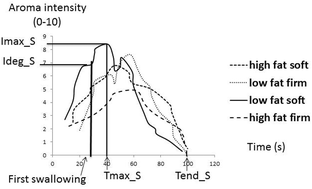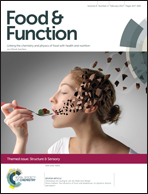Model cheese aroma perception is explained not only by in vivo aroma release but also by salivary composition and oral processing parameters†
Abstract
The aim of the present paper was to determine, from four model cheeses differing in fat content and firmness and consumed by fourteen well characterised subjects, the respective impacts of in vivo aroma release, bolus rheology, chewing activity, mouth coating and salivary composition on dynamic aroma perception. The originality of the approach is that it considers all the parameters together and is able to evaluate their relative contribution using multi-block partial least square (MB-PLS) regression. The fruity aroma perception of the more hydrophilic compound (ethyl propanoate) was related to its dynamic release parameters before swallowing whereas the blue cheese aroma perception of the more hydrophobic compound (nonan-2-one) was related to its dynamic release parameters after swallowing and was highly impacted by mouth coating. Moreover the MB-PLS approach made it possible to evidence the combined effects of saliva composition and cross-modal interactions to understand why in some cases dynamic aroma perception could not be explained by dynamic in vivo aroma release data. Subjects with a low sodium content in saliva perceived fruity aroma which is not congruent with saltiness as less intense and salt- congruent (blue cheese) aroma as more intense, which was explained by their higher sensitivity to salt. Subjects with high lipolysis activity perceived fruity aroma which is not congruent to fat as less intense and fat-congruent (blue cheese) aroma as more intense, which should be explained by the link between lipolysis activity and fat sensitivity. These results could be considered for the reformulation of foods towards specific populations taking into account nutritional recommendations.

- This article is part of the themed collection: Structure & Sensory

 Please wait while we load your content...
Please wait while we load your content...